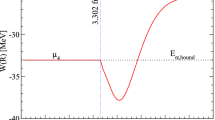Abstract
Geometrical structures of low-energy states in the \({}^{12}\)C nucleus are investigated using density distributions obtained from three \(\alpha \)-particle wave functions calculated for a set of phenomenological \(2\alpha \)- and \(3\alpha \) potentials by Faddeev technique. Calculated shapes of triangles that three \(\alpha \)-particles form are classified to either an equilateral triangle, an isosceles triangle, or a mixture of these with various sizes, which may characterize the excitation mechanism of the states




Similar content being viewed by others
Data Availibility
No datasets were generated or analysed during the current study.
References
S. Ishikawa, Three-body calculations of the triple-\(\alpha \) reaction. Phys. Rev. C 87, 055804 (2013). https://doi.org/10.1103/PhysRevC.87.055804
S. Ishikawa, Decay and structure of the Hoyle state. Phys. Rev. C 90, 061604(R) (2014). https://doi.org/10.1103/PhysRevC.90.061604
S. Ishikawa, Monopole transition strength function of \({}^{12}\)C in a three-\(\alpha \) model. Phys. Rev. C 94, 061603(R) (2016). https://doi.org/10.1103/PhysRevC.94.061603
N.B. Nguyen, F.M. Nunes, I.J. Thompson, Investigation of the triple-\(\alpha \) reaction in a full three-body approach. Phys. Rev. C 87, 054615 (2013). https://doi.org/10.1103/PhysRevC.87.054615
H. Moriya, W. Horiuchi, J. Casal, L. Fortunato, Three-\(\alpha \) configurations in the \(0^+\) states of \({}^{12}\)C. Few-Body Syst. 62, 46 (2021). https://doi.org/10.1007/s00601-021-01631-2
R. Bijker, F. Iachello, The algebraic cluster model: three-body clusters. Ann. Phys. 298, 334 (2002). https://doi.org/10.1006/aphy.2002.6255
A. Vitturi, J. Casal, L. Fortunato, E.G. Lanza, Transition densities and form factors in the triangular \(\alpha \)-cluster model of \({}^{12}\)C with application to \({}^{12}\rm C+\alpha \) scattering. Phys. Rev. C 101, 014315 (2020). https://doi.org/10.1103/PhysRevC.101.014315
L. Fortunato, Detailed studies of 12C structure and reactions. Few-Body Syst. 65, 1 (2024). https://doi.org/10.1007/s00601-023-01870-5
T. Otsuka, T. Abe, T. Yoshida, Y. Tsunoda, N. Shimizu, N. Itagaki, Y. Utsuno, J. Vary, P. Maris, H. Ueno, \(\alpha \)-Clustering in atomic nuclei from first principles with statistical learning and the Hoyle state character. Nat. Commun. 13, 2234 (2022). https://doi.org/10.1038/s41467-022-29582-0
S. Shen, S. Elhatisari, T.A. Lähde, D. Lee, B.N. Lu, U.-G. Meißner, Emergent geometry and duality in the carbon nucleus. Nat. Commun. 14, 2777 (2023). https://doi.org/10.1038/s41467-023-38391-y
S. Ali, A.R. Bodmer, Phenomenological \(\alpha \)-\(\alpha \) potentials. Nucl. Phys. 80, 99 (1966). https://doi.org/10.1016/0029-5582(66)90829-7
J.H. Kelley, J.E. Purcell, C.G. Sheu, Energy levels of light nuclei \(A = 12\). Nucl. Phys. A 968, 71 (2017). https://doi.org/10.1016/j.nuclphysa.2017.07.015
S. Ishikawa, H. Kamada, W. Glöckle, J. Golak, H. Witała, Response functions of three-nucleon systems. Phys. Lett. B 339, 293 (1994). https://doi.org/10.1016/0370-2693(94)90620-3
L.D. Faddeev, Scattering theory for a three particle system. Zh. Eksp. Teor. Fiz. 39, 1459 (1961). (Sov. Phys. JETP 12, 1014 (1961))
T. Sasakawa, S. Ishikawa, Triton binding energy and three-nucleon potential. Few-Body Syst. 1, 3 (1986). https://doi.org/10.1007/BF01075288
Y. Wu, S. Ishikawa, T. Sasakawa, Three-nucleon bound states: detailed calculations of \({}^3\)H and \({}^3\)He. Few-Body Syst. 15, 145 (1993). https://doi.org/10.1007/BF01076246
S. Ishikawa, Low-energy proton-deuteron scattering with a Coulomb-modified Faddeev equation. Few-Body Syst. 32, 229 (2003). https://doi.org/10.1007/s00601-003-0001-7
S. Ishikawa, Coordinate space proton-deuteron scattering calculations including Coulomb force effects. Phys. Rev. C 80, 054002 (2009). https://doi.org/10.1103/PhysRevC.80.054002
H. Suno, Y. Suzuki, P. Descouvemont, Precise calculation of the triple-\(\alpha \) reaction rates using the transmission-free complex absorbing potential method. Phys. Rev. C 94, 054607 (2016). https://doi.org/10.1103/PhysRevC.94.054607
K.W.C. Li, R. Neveling, P. Adsley, H. Fujita, P. Papka, F.D. Smit, J.W. Brümmer, L.M. Donaldson, M.N. Harakeh, T. Kokalova, E. Nikolskii, W. Paulsen, L. Pellegri, S. Siem, M. Wiedeking, Understanding the total width of the \(3_1^-\) state in \({}^{12}\)C. Phys. Rev. C 109, 015806 (2024). https://doi.org/10.1103/PhysRevC.109.015806
W. Ruckstuhl, B. Aas, W. Beer, I. Beltrami, K. Bos, P.F.A. Goudsmit, H.J. Leisi, G. Strassner, A. Vacchi, F.W.N. De Boer, U. Kiebele, R. Weber, Precision measurement of the 2p–1s transition in muonic \({}^{12}\)C: search for new muon-nucleon interactions or accurate determination of the RMS nuclear charge radius. Nucl. Phys. A 430, 685 (1984). https://doi.org/10.1016/0375-9474(84)90101-5
Acknowledgements
This work used computational resources of the Laboratory provided by the Research Center for Computing and Multimedia Studies, Hosei University (Project ID: LAB-464).
Ethics declarations
Conflict of interest
The authors declare that they have no conflict of interest.
Additional information
Publisher's Note
Springer Nature remains neutral with regard to jurisdictional claims in published maps and institutional affiliations.
Rights and permissions
Springer Nature or its licensor (e.g. a society or other partner) holds exclusive rights to this article under a publishing agreement with the author(s) or other rightsholder(s); author self-archiving of the accepted manuscript version of this article is solely governed by the terms of such publishing agreement and applicable law.
About this article
Cite this article
Ishikawa, S. Structure of Resonance States in Three-Alpha Systems. Few-Body Syst 65, 50 (2024). https://doi.org/10.1007/s00601-024-01922-4
Received:
Accepted:
Published:
DOI: https://doi.org/10.1007/s00601-024-01922-4




